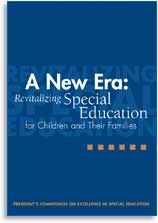|

People of Color in Psychiatry’s Cross Hairs
|
• •
• • • • • • • • •
|

“Minority children are much more likely to be placed in the emotional disturbance category because of behavioral characteristics associated with the cultural context in which a child is raised.” — “A New Era: Revitalizing Special Education”
|
|
• •
• • • • • • • • •
|
The President’s Commission on Excellence in Special Education issued a report in July 2002 entitled A New Era: Revitalizing Special Education, finding that minority children are over-represented in some special-education categories:
“This is especially apparent for African-American males in high-incidence categories such as mental retardation and emotional disturbance. The recent National Research Council report on minority representation in special education found that African-American children are twice as likely as whites and American Indians/ Alaskan natives to be identified for the mental retardation category.
“In the emotional disturbance category, black students are about half more likely than white students to be classified in this category.
“The Commission found that several factors were responsible for this over-representation, including the reliance on IQ tests that have known cultural bias. This may result in more minority children being identified in the mental retardation category as opposed to the Specific Learning Disorder category.
“Minority children are much more likely to be placed in the emotional disturbance category because of behavioral characteristics associated with the cultural context in which a child is raised. A major factor is the role of teacher referral. In some studies, teachers refer more than 80 percent of children who are placed in a high-incidence category. To the extent that teachers are not prepared to manage behavior or instruct those with learning characteristics that make them ‘at risk’ in general education, minority children will be more likely to be referred.”1
A Call for Cultural Awareness
“Cultural competency is extremely important, especially in diagnosis, when we are identifying and labeling,” says Dr. Nedra Jones, executive committee member of the Silicon Valley chapter of the National Association for the Advancement of Colored People. “You have to be careful with labels, because they stick and they mean different things in different settings.... For the most part they’re detrimental, because we don’t understand each other as a people. We think we do.”
Jones challenges the criteria set — and by whom — for the “mentally ill” labeling of minority youth. Are observable behaviors culturally sensitive?
“Violent behavior or behavior that is unacceptable socially may, if one is on the street, be a survival skill. We see this in schools, where kids are placed on Ritalin and different medications. People who, with no cultural awareness or background — or awareness of the family for that matter — could make recommendations that are not in keeping with what is usual and customary and normal.”
Jones points, as well, to how easy it is for law enforcement officers, for instance, to misjudge behavior in potentially threatening circumstances and, as an example, to “take [loud, animated] behaviors as being belligerent, being angry, when often they are just fearful — or they don’t know what to do....”
The same can, more easily than not, take place in routine psychiatric evaluations that lead to the mandatory mental health system “treatment” sought by Proposition 63 sponsors and proponents.
How Not to be Fooled
 CULTURALLY INSENSITIVE LABELING MUST BE HALTED, advises Dr. Nedra Jones, executive committee member of the Silicon Valley NAACP chapter, which opposes Prop 63.
CULTURALLY INSENSITIVE LABELING MUST BE HALTED, advises Dr. Nedra Jones, executive committee member of the Silicon Valley NAACP chapter, which opposes Prop 63.
|
Emotional disturbance labels are taken from psychiatric “disorders.” Any expansion of the mental health industry will result in more black children being labeled and placed on dangerous drugs to satisfy a bigoted observer. But, since racist maneuverings may not be readily apparent in the gilded vernacular of the profit-motivated “compassionates” beating the drum for Prop 63, here is just one county’s sampling of what you might find behind the rhetoric.
Santa Clara County’s (SCC) Child Protective Service has shown a definite pattern of bias against the African-American community. SCC, “with a disproportionate number of white social workers,” said Jones, has been found to have institutional bias against people of color. A study was undertaken to assess the how and why. It was a three-year evaluation of factors related to the disproportionate representation of children of color in the child welfare system.2
African-Americans represent 4 percent of the general population, yet they comprised 32.9 percent of the children in foster homes. Latinos represent 32 percent of the population but are 43 percent of the foster child caseload. White children reportedly make up 45 percent of the general population but were only 25 percent of the foster care cases.
Santa Clara County has an overall substantiation rate of child abuse or neglect of 17 percent. It was found that white children are at a 15.4 percent rate of substantiation, while blacks were at 21 percent.3 Considering the predominance of white social workers, this demonstrates a clear bias against the black community and culture.
Social workers use the diagnostic manual of the mental health industry to apply labels to the people they investigate. (See “Manufacturing ‘Madness’.”) Prop 63 will create a dragnet that seeks to pull in as many people as possible to their one and only model of “help”— drugs.
To protect your loved ones from psychiatric labeling and drugging, contact the Citizens Commission on Human Rights in Northern California at (800) 330-7290 or in Southern California at (323) 663-2247.
To save children and adults — regardless of their culture or color — from unscientific psychiatric diagnoses and drugging, vote “NO!” on Proposition 63.
|

